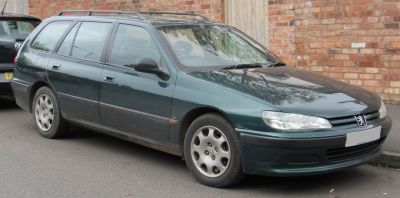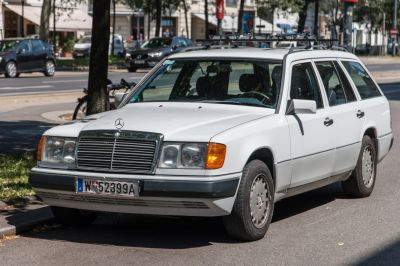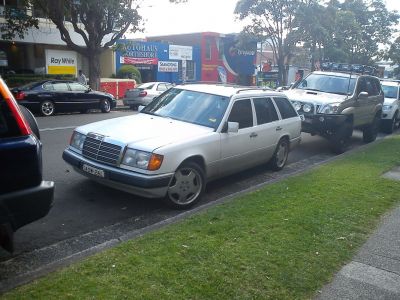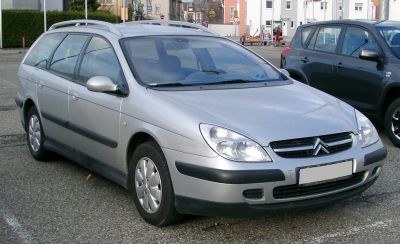 1986 Renault 21 Combi (K48) Dimensions, Size & Specs
1986 Renault 21 Combi (K48) Dimensions, Size & SpecsMeasurements of the 1986 Renault 21 Combi, engineered for optimal performance and comfort
| Dimensions | |
|---|---|
| Length: | 4693 mm184.8 in15.4 ft |
| Width: | 1726 mm68.0 in5.7 ft |
| Height: | 1450 mm57.1 in4.8 ft |
| Trunk Capacity: | 674-675 liter23.8-23.8 cu ft |
| Trunk Capacity (Max): | 1694 liter59.8 cu ft |
| Weight Specifications | |
| Curb Weight: | 1044-1315 kg2302-2899 lbs |
| Maximal permitted Weight: | 1665-1835 kg3671-4045 lbs |
| Tire Specifications | |
| Rims Sizes: |
|
| Tire Sizes: |
|
The Renault 21 Combi (K48), produced from 1986 to 1995, is a versatile station wagon that combines spaciousness and practicality in a mid-size family vehicle. Measuring 4693 mm (184.7 inches) in length, 1723 to 1726 mm (67.8 to 68 inches) in width, and standing 1450 mm (57.1 inches) tall, it offers a balanced footprint suitable for both urban and longer-distance driving.
Curb weight ranges from 1044 to 1315 kg (2302 to 2900 lbs), depending on trim and equipment, with a maximum gross weight between 1665 and 1835 kg (3671 to 4046 lbs). This weight variation reflects different configurations and options available during its production period.
One of the highlights of the Renault 21 Combi is its generous luggage capacity. The rear cargo holds between 674 and 675 liters (23.8 to 23.8 cubic feet) behind the rear seats, making it ideal for daily errands or family outings. Fold the rear seats down, and the capacity expands substantially to 1694 liters (59.8 cubic feet), offering ample space for bulky items or extended trips.
The car rides on a variety of rim sizes including 13, 14, and 15 inches, with a range of tire sizes such as 175/65 R14, 185/65 R14, and 185/55 R15, catering to different driving preferences and trim levels.
Overall, the Renault 21 Combi (K48) stands out in the station wagon segment of the late 1980s and early 1990s for its roomy interior, practical cargo space, and balanced dimensions that make it both maneuverable and comfortable. Its weight and size classification place it comfortably among mid-size European wagons of its era, offering a dependable option for families needing flexibility in their vehicle.
Discover the standout features that make the 1986 Renault 21 Combi a leader in its class
Have a question? Please check our knowledgebase first.
The Renault 21 Combi (K48) produced between 1986 and 1995 measures 4693 mm (approximately 184.7 inches) in length, 1723 to 1726 mm (67.8 to 67.9 inches) in width, and 1450 mm (57.1 inches) in height. These dimensions offer a spacious profile typical of mid-sized station wagons from its era, balancing road presence while maintaining maneuverability on urban roads and highways.
The curb weight of the Renault 21 Combi ranges from 1044 to 1315 kilograms (approximately 2302 to 2898 pounds), reflecting variations based on model variants and equipment levels. The maximum permissible weight, which includes passengers and cargo, ranges between 1665 and 1835 kilograms (3672 to 4047 pounds). This range ensures the vehicle can carry substantial loads, making it practical for families and cargo transport.
The luggage compartment of the Renault 21 Combi offers a spacious cargo volume of approximately 674 to 675 liters (about 23.8 to 23.8 cubic feet) with the rear seats up, providing ample space for everyday storage needs. When the rear seats are folded down, the luggage space expands significantly to around 1694 liters (approximately 59.8 cubic feet), making it highly versatile for carrying larger items or increased cargo, which is ideal for traveling or transporting bulky goods.
Yes, the Renault 21 Combi's dimensions allow it to fit comfortably into a standard residential garage. With a height of 1450 mm (57.1 inches) and a width of roughly 1723 to 1726 mm (67.8 to 67.9 inches), it is well-suited for typical garage door widths (usually around 2.4 to 2.7 meters or 7.9 to 8.9 feet) and ceiling heights. Owners generally do not experience clearance issues, making it practical for everyday residential parking.
Compared to its predecessor, the Renault 21 Combi (K48) introduced in 1986 showcased a slightly longer and wider body, emphasizing increased interior space and practicality. The length of 4693 mm (184.7 inches) and width of about 1725 mm (67.9 inches) typically surpassed earlier models, improving cargo volume and passenger comfort. Height and weight were also optimized for better stability and driving dynamics, reflecting Renault’s commitment to modernization while retaining station wagon versatility.
The Renault 21 Combi (K48) came equipped with multiple rim size options including 13, 14, and 15 inches, catering to different performance and comfort preferences. Tire sizes compatible with these rims included 175/65 R14, 175/65 R14 T, 175/65 R13, 185/65 R14, 185/55 R15, 175/70 R13, and 185/65 R14 H. These tire specifications provided a balance between ride comfort, handling stability, and load-carrying capacity appropriate for a mid-size station wagon of its generation.
The Renault 21 Combi’s width ranging from 1723 mm to 1726 mm (67.8 to 67.9 inches) provides a stable and comfortable driving experience by improving road grip and reducing body roll during cornering. Additionally, the fairly wide stance enhances interior room, especially for front and rear passengers, offering ample shoulder space which contributes to passenger comfort on longer journeys. This width also supports better accommodation of side-impact safety features typical of the era.
When compared to other station wagons from the late 1980s to early 1990s, the Renault 21 Combi held its own with its substantial length of 4693 mm (184.7 inches) and generous cargo space up to 1694 liters (59.8 cubic feet) with seats folded. Unlike smaller or sportier wagons, it prioritized passenger comfort and load flexibility, making it competitive in the mid-size family wagon segment. Its curb weight range of approximately 1044 to 1315 kg (2302 to 2898 lbs) also helped it maintain fuel efficiency compared to heavier competitors.
The Renault 21 Combi’s height of 1450 mm (57.1 inches) was chosen to strike a balance between aerodynamics, interior headroom, and ease of access. This modest height ensured a lower center of gravity for better handling stability and reduced wind resistance to improve fuel economy. Simultaneously, it provided sufficient headroom for passengers without compromising the sleek, wagon-style silhouette preferred in the segment during the time period of 1986 to 1995.
The Renault 21 Combi’s wide range of tire sizes, including 175/65 R14 and 185/55 R15, allows owners to prioritize either comfort or sportier handling. Tires with a higher profile, such as 175/70 R13, generally provide a softer ride by absorbing road imperfections, while lower-profile tires like 185/55 R15 can enhance cornering precision and improve traction. This flexibility in tire size helps the vehicle adapt to different driving needs and road conditions.
Discover similar sized cars.

| Production: | 2001-2007 |
|---|---|
| Model Year: | 2001 |
| Length: | 4765-4800 mm187.6-189.0 in |
| Width: | 1760-1790 mm69.3-70.5 in |
| Height: | 1510-1550 mm59.4-61.0 in |

| Production: | 1996-1999 |
|---|---|
| Model Year: | 1996 |
| Length: | 4725-4740 mm186.0-186.6 in |
| Width: | 1765 mm69.5 in |
| Height: | 1505 mm59.3 in |

| Production: | 1988-1994 |
|---|---|
| Model Year: | 1989 |
| Length: | 4744 mm186.8 in |
| Width: | 1760 mm69.3 in |
| Height: | 1490 mm58.7 in |

| Production: | 1988-1993 |
|---|---|
| Model Year: | 1988 |
| Length: | 4595-4770 mm180.9-187.8 in |
| Width: | 1720 mm67.7 in |
| Height: | 1445-1490 mm56.9-58.7 in |

| Production: | 1989-1993 |
|---|---|
| Model Year: | 1989 |
| Length: | 4765 mm187.6 in |
| Width: | 1740 mm68.5 in |
| Height: | 1489-1497 mm58.6-58.9 in |

| Production: | 1985-1989 |
|---|---|
| Model Year: | 1985 |
| Length: | 4765 mm187.6 in |
| Width: | 1740 mm68.5 in |
| Height: | 1490-1498 mm58.7-59.0 in |

| Production: | 2001-2008 |
|---|---|
| Model Year: | 2001 |
| Length: | 4760 mm187.4 in |
| Width: | 2100 mm82.7 in |
| Height: | 1520 mm59.8 in |
